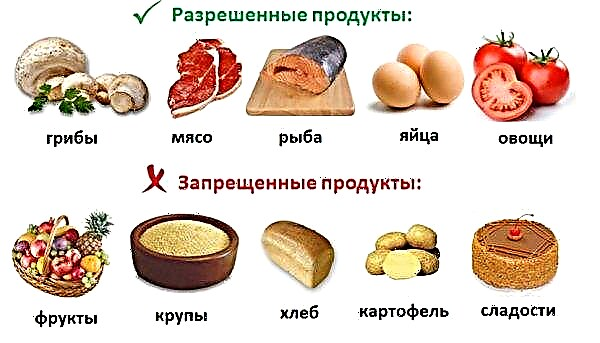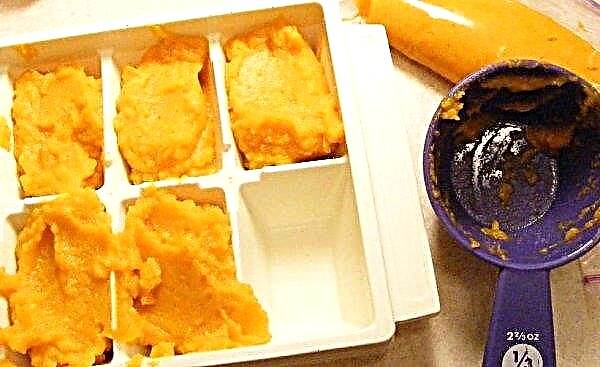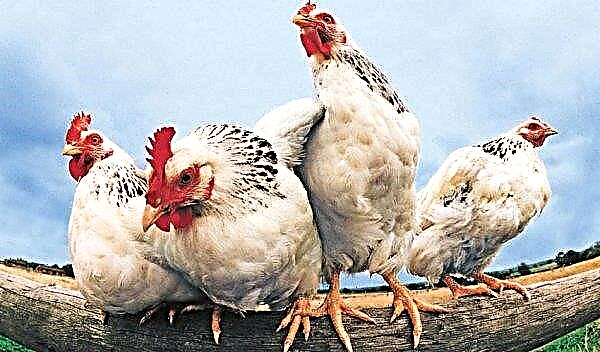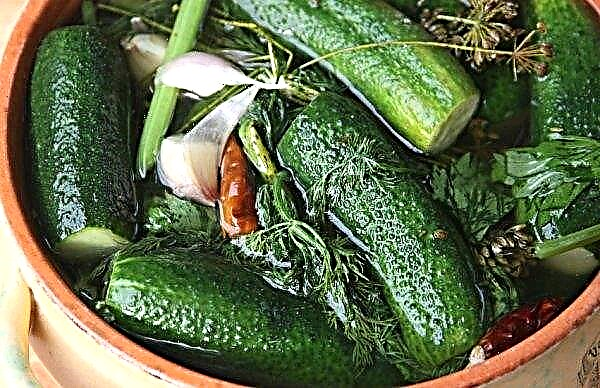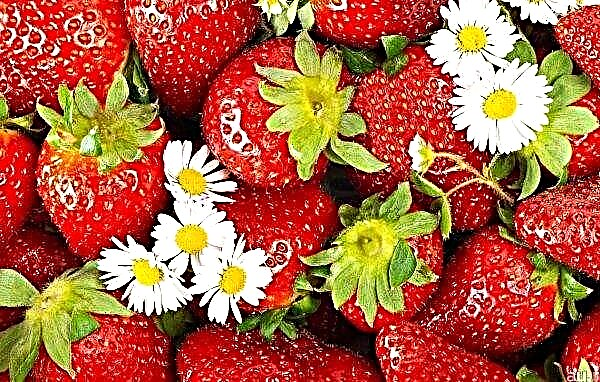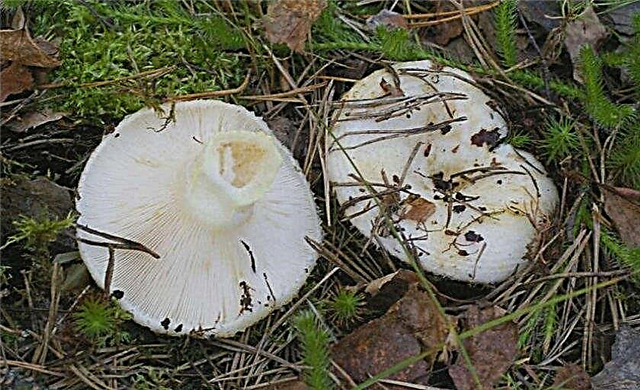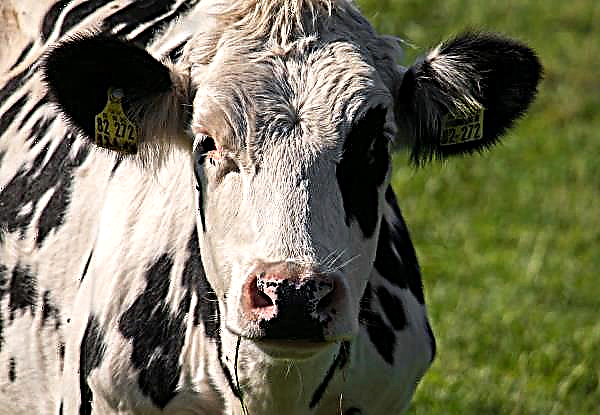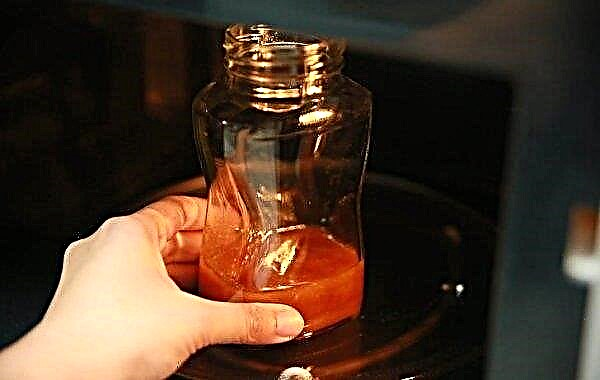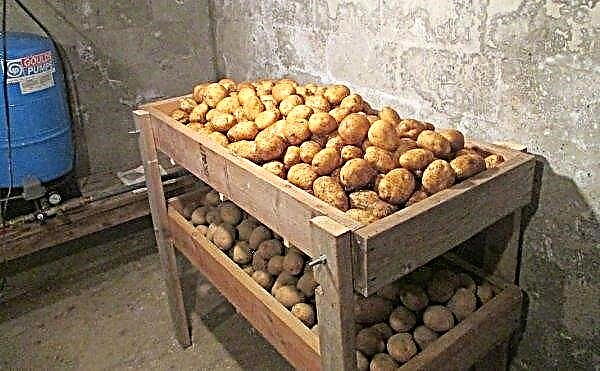Which flower grower wouldn’t want to have a house at home, blooming almost the whole year, and even with unusually beautiful leaves? These include anthurium. People call it “flamingo” or “masculine happiness”, for the shape and beauty of the flowers.
Description and characteristics of the plant
Anthurium belongs to the genus Aroid and came to us from the forests of South and Central America, where there are about 500 of its species. In the natural environment, this flower is an epiphyte, that is, it grows on trees, snags, roots of other plants.
Did you know? According to the Chinese, the Anthurium flower represents male energy and symbolizes money and success.
The inflorescence resembles an ear of white (or yellow) and does not stand out much. Attractiveness is given by a heart-shaped veil, which is red, purple, pink and even black. When the flowering period ends, the veil turns into a green leaf. Leaf plates are dense, heart-shaped, green. In captivity, “male happiness” grows to 70 cm.
Preparing a plant for planting a house
Despite its tropical origin, flamingos take root and grow well in apartment conditions.

How to choose a pot for anthurium?
Choosing a pot for this beauty, take into account the following points:
- There should be large drainage holes along the bottom, since the roots of the epiphyte must breathe, and they respond poorly to stagnation of moisture.
- Do not plant anthurium in clay pots, as they have only one hole. Clay is also saturated with moisture and attracts cold.
- The flowerpot should be the same in width and height, and its diameter is 2-3 cm larger than the previous one. In a large pot, “flamingos” will not soon be pleased with flowers, because at first it will grow roots.
Soil for anthuriums
To achieve long-term flowering, it is important to give the plant the soil that suits it.
Its roots are similar to the roots of orchids, and their soil requirements are similar:
- good passability of water and air;
- slightly acid reaction;
- lack of lumps.

You can make the soil yourself - mix 1: 1 purchased universal soil and pieces of pine bark. The universal substrate has a weak acidity, as there is enough peat in the composition. And the bark will give the necessary airspace inside the pot.
Also to this mixture is added the choice of:
- perlite for sorption of moisture;
- chopped charcoal;
- river sand;
- expanded clay;
- broken red brick;
- moss sphagnum.
You can take one or several components at once.
If the bark is not purchased, but collected in the forest, it should be from healthy trees, not covered with green moss, without pests. Also, it must first be disinfected with boiling water or a solution of potassium permanganate.
Location
Anthurium needs enough daylight. However, direct sunlight does not suit him. It is better to allocate a place for a flower on a window facing east or west. Also, this tropical resident cannot be placed on drafts and near batteries.

Landing technology
Before starting the transplant, the plant is well watered and wait 15 minutes - this is enough for the roots to be freely removed from the flowerpot. If they are too tight in the flowerpot, you can knock on the edges. Next, the root system is inspected for rot, the death of roots and the presence of pests. If everything is in order, and the plant develops, then the soil does not change - just transfer it to a larger pot, and add new soil from the sides.
If the roots have traces of decay, you will have to take a number of measures:
- To remove the old earth, washing them under a stream of warm water.
- Trim damaged areas.
- Slices treated with crushed tablets of activated carbon or cinnamon.
Did you know? The name "Anthurium" is a combination of the Greek words "Antos" (flower) and "Ora" (tail). Literally - "a flower with a tail."
Then proceed to landing in another tank. Any drainage is laid on the bottom: polystyrene, broken brick, expanded clay. Drainage needs about 1/3 of the capacity. Then there is a layer of earth about 3 cm, on which they put a lump with roots. The sides are filled with fresh soil. To hold moisture up, you can lay out sphagnum. You can plant a plant for the purpose of reproduction by a process that is neatly separated from the mother flower. The landing pattern is the same.
Proper care after landing
Caring for “flamingos” after transshipment is no different from normal, as the roots are not damaged. But after a complete transplant, with cutting the roots, more attention will be needed.
Microclimate
This resident of the tropics is thermophilic, and in the autumn-winter period the temperature needs a minimum of + 16 ° C. In summer - + 27 ° C. The main thing that does not fit the anthurium in urban apartments is dry air. In winter, when central heating dries the air, you need to moisten the space around the flower from a small spray bottle. It will also be useful to purchase a humidifier, especially since its work will be useful not only to the flower, but also to people. If this is not possible, you can install a flowerpot on wet expanded clay.
Watering
Watering is carried out not earlier than the drying of the soil at half the height of the pot, adding “Fitosporin” or another anti-fungal agent to the water.
Important! After transplanting, the plant should not be watered, as the cut roots can rot.
Pest and Disease Control
Diseases are divided into viral, fungal and non-infectious. To find the right treatment, you need to determine what kind of disease has overtaken a flower.
Of the fungal infections for anthurium, the most terrible:
- Powdery mildew. Affected leaves become small, curl and turn yellow. Light gray fungal spores appear on the reverse side. For treatment, the plant is isolated and treated with fungicide.

- Rust - The top of the sheet is covered with bright spots. Brown spots appear below, which merge over time, and the leaf dries out as a result. All diseased sheets must be removed and the plant sprayed with a chemical and quarantined.

- Septoria - manifested by brown spots of irregular shape, with a brown or yellow border. Small black dots are visible under the magnifying glass. Treatment: cut off the diseased parts of anthurium, stop spraying, reduce air humidity. He also needs additional fertilizer for flowering plants, which will give strength to fight the disease.

- Fusarium - general wilting of leaves. They turn yellow and dry. Such foliage will soon fall. The stem closer to the root is covered with a white-pink coating. The disease is extremely dangerous and contagious. It is transmitted through water during irrigation, under conditions of high humidity and in heat. At the initial stage of the disease, the stems of the plant can be sprayed with fungicide, and soil pesticide can be added to the soil. Repeat treatment after 7 days. Unfortunately, there is no effective treatment for this disease. Most likely, the affected plant will die.

- Stem rot occurs when the flower is constantly poured and water stagnates in the pan. Black watery spots appear on the stem, which then pass onto the leaves. The infected parts die off. You can cure if the disease is not running. It is necessary to remove all diseased parts and treat with fungicide twice, with an interval of a week. A flowerpot with a plant must be isolated.

- Root rot. The causes of the disease are excessive watering and low temperature. Symptoms: pallor and wilting of leaf blades. The roots become soft, frayed. Cut dead leaves and reduce humidity.

To resuscitate a flower you need:
- get it out of the flowerpot;
- wash off all soil;
- trim rotted roots to healthy tissue;
- sprinkle slices with charcoal;
- plant in a new pot;
- pour “Fitosporin-M”.
There are also non-communicable diseases that arise from improper maintenance:
- Chlorosis - arises from a lack of magnesium and iron. In bright light, yellow spots are noticeable on leaf blades. It is necessary to timely feed, which contain these elements.
- Of enations - the leaves become crooked, hunchbacked, ugly. It occurs with a sharp difference in temperature and humidity. It is necessary to normalize the microclimate.
- Smallpox - It affects at low temperature and high humidity. Yellow ring-shaped spots and bulges are visible on the leaves.
- Thrips. Their presence is indicated by light yellow spots on the surface of the leaves. On the reverse side you can see the brown spots. These are insects. They are etched by Tanrek, Aktellik. It will take several treatments with an interval of 4 days. Also, these pests love when it is hot and humid, which means that you need to reduce these indicators.

- Aphid. Leaf plates become sticky, curl, turn yellow. If there are few pests, you can wash them off with warm water and treat them with a soapy solution. If it didn’t help, the treatment with the insecticides Actellik and Aktara.

- Shield - the appearance on the stems of tubercles of white or golden color. If there are few pests, they are removed with a toothbrush, and then all the stems are treated with kerosene.

- Spider mite. Causes the appearance of yellow specks, which merge into yellow spots. Below the cobweb and small insects. It is necessary to lower the temperature and increase the humidity. Each sheet is washed with a soapy sponge and mineral oil is applied.

Useful Tips
Florists have a list of tips on how to properly grow this tropical beauty:
- if top dressing gives a positive result, do not change it;
- Keep away from drafts and direct sun;
- water when 1/3 of the soil is dry;
- soften water for irrigation;
- This species of plants is poisonous, therefore, children and animals cannot be in contact with it.
Important! All parts of the plant are poisonous. Swallowing them can lead to upset stomach and inflammation, and pollen can cause skin irritation.
If you like to collect unusual and beautiful plants, then the flamingo flower is for you. Of course, it is demanding, since the natural environment differs from the climate in our homes, but in return for the care, the plant thanks it with bright flowering.











